Pierre-Narcisse Guérin, later Baron Guérin, stands as a significant, if sometimes overlooked, figure in the annals of French art history. Born in Paris on May 13, 1774, and passing away in Rome on July 6, 1833, Guérin's career spanned a tumultuous and transformative period in France, from the fervor of the Revolution through the Napoleonic Empire and into the Bourbon Restoration. He was a distinguished painter of the Neoclassical school, a highly respected teacher who nurtured some of the brightest talents of the subsequent Romantic generation, and a pivotal artist whose work, while rooted in classical ideals, often hinted at the burgeoning emotionalism that would come to define the next artistic era.
Early Life and Artistic Formation
Born into a Paris still steeped in the traditions of the Ancien Régime but on the cusp of radical change, Pierre-Narcisse Guérin's artistic inclinations were evident from a young age. His formal training began under the tutelage of Jean-Baptiste Regnault, a prominent Neoclassical painter and a rival to the great Jacques-Louis David. Regnault's studio provided Guérin with a solid grounding in academic principles: a strong emphasis on drawing, the study of anatomy, and the emulation of classical sculpture and Renaissance masters.
This rigorous training prepared him well for the prestigious competitions of the Académie Royale de Peinture et de Sculpture (later the École des Beaux-Arts). In 1797, Guérin achieved a significant early success by winning one of the coveted Prix de Rome scholarships. The Prix de Rome was the ultimate accolade for a young French artist, granting a funded period of study at the French Academy in Rome. His winning entry, The Death of Cato of Utica, demonstrated his mastery of historical subjects, dramatic composition, and the clear, linear style characteristic of Neoclassicism. This victory was particularly noteworthy as the competition had been intermittently disrupted by the Revolution, and its revival signaled a return to, and re-evaluation of, cultural institutions.
The Salon Sensation: The Return of Marcus Sextus
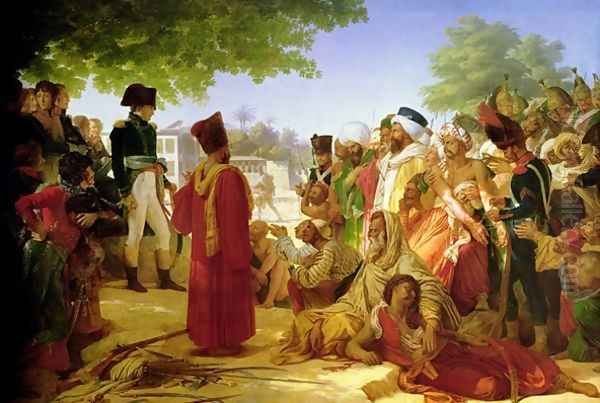
Although the Prix de Rome secured his path to Italy, it was his 1799 Paris Salon debut with The Return of Marcus Sextus that catapulted Guérin to national fame. The painting depicts a Roman proscript, Marcus Sextus, returning from exile to find his wife dead and his daughter in despair. The work caused an immense sensation, resonating deeply with a French public still grappling with the trauma, loss, and dislocation wrought by the Revolution and the Reign of Terror.
The painting's power lay not just in its impeccable Neoclassical technique – the sculptural figures, the balanced composition, the somber palette – but in its profound emotional charge. Audiences saw in Marcus Sextus a reflection of their own experiences: the émigrés returning to find their families and fortunes shattered, the pervasive sense of grief, and the stoic endurance in the face of tragedy. Théodore Géricault, who would later become Guérin's student, was profoundly moved by the painting as a young man. The work was so popular that it was reportedly surrounded by crowds for days, and poems were written in its honor. It established Guérin as a leading painter of his generation, capable of imbuing classical subjects with contemporary relevance and palpable pathos. This success also brought him to the attention of influential patrons, including Napoleon Bonaparte himself.
Neoclassical Ideals and Thematic Choices
Guérin's artistic output remained firmly rooted in Neoclassicism, the dominant style of the era, championed by Jacques-Louis David. This style emphasized order, clarity, moral virtue, and idealized human forms, drawing inspiration from the art and literature of ancient Greece and Rome. Guérin, like David, often chose subjects from classical history, mythology, and literature, which were seen as vehicles for conveying timeless truths and noble sentiments.
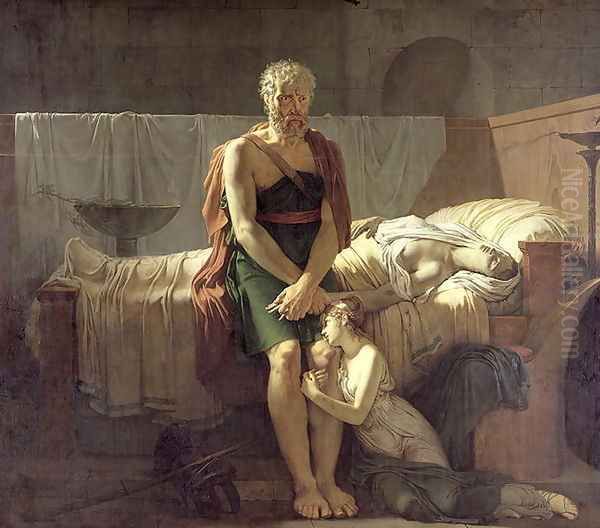
His compositions were typically carefully structured, often with a frieze-like arrangement of figures in the foreground, reminiscent of classical reliefs. Drawing was paramount, with clean outlines and precisely rendered forms. Color, while often rich, was generally subordinate to line and served to enhance the clarity of the narrative and the sculptural quality of the figures. However, Guérin's Neoclassicism was often softer and more theatrical than David's sterner, more overtly political works. While David's paintings like The Oath of the Horatii or The Death of Marat carried strong revolutionary or republican messages, Guérin's art, particularly after Marcus Sextus, often focused more on personal drama, psychological states, and moments of intense emotion within a classical framework. He was also influenced by the great French classical painter of the 17th century, Nicolas Poussin, known for his intellectually rigorous and emotionally resonant historical and mythological scenes.
Key Masterpieces: A Gallery of Drama and Emotion
Throughout his career, Guérin produced a series of significant works that further cemented his reputation and showcased his evolving style.
Aeneas Relating to Dido the Misfortunes of Troy (c. 1815, Louvre): This painting, commissioned for the Château de Malmaison by Empress Josephine, depicts a scene from Virgil's Aeneid. Aeneas, the Trojan hero, recounts the tragic fall of his city to Dido, the Queen of Carthage. Guérin captures the moment of intense storytelling, with Dido listening raptly, her expression a mixture of sympathy and burgeoning love. The figures are noble and graceful, the setting opulent, and the lighting dramatic, highlighting the emotional exchange. The work exemplifies Guérin's skill in portraying complex psychological interactions within a grand historical narrative.
Andromache and Pyrrhus (1810, Louvre): Based on Jean Racine's tragedy Andromaque, this painting illustrates a tense confrontation. Andromache, Hector's widow, pleads with Pyrrhus, son of Achilles, for the life of her son Astyanax. Pyrrhus, torn between his love for Andromache and political expediency, presents a formidable figure. The composition is highly theatrical, with exaggerated gestures and expressions conveying the high emotional stakes. This work, with its focus on passionate conflict and dramatic intensity, shows Guérin pushing the boundaries of Neoclassical restraint, hinting at the Romantic sensibilities that would soon flourish.
Clytemnestra Hesitating before Killing the Sleeping Agamemnon (1817, Louvre): Another scene of high drama drawn from Greek tragedy, this painting captures the terrifying moment of indecision before a fateful act. Clytemnestra, dagger in hand, stands over her sleeping husband, Agamemnon, her face a mask of conflicting emotions – resolve, fear, hatred. The stark lighting, casting deep shadows, heightens the suspense and the psychological horror of the scene. Guérin masterfully conveys the internal struggle of his protagonist, making this a compelling study of human passion and vengeance.
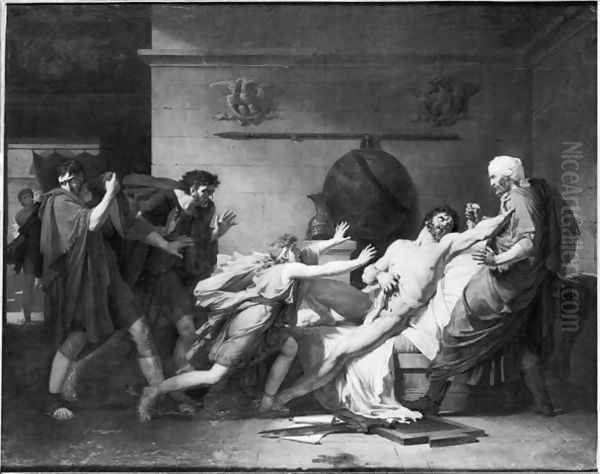
Napoleon Pardoning the Rebels at Cairo (1808, Musée National des Châteaux de Versailles et de Trianon): Like his contemporary Antoine-Jean Gros, Guérin also contributed to the Napoleonic propaganda machine, though perhaps less extensively. This painting depicts an episode from Napoleon's Egyptian campaign, where he is shown magnanimously pardoning captured rebels. Napoleon is presented as a calm, authoritative figure, embodying clemency and power. The work combines Neoclassical clarity with a touch of the exoticism and grandeur associated with Napoleonic imagery. It demonstrates Guérin's versatility in handling contemporary historical subjects alongside classical ones.
Sappho on the Leucadian Cliff (1801, private collection, but versions exist): This subject, popular among artists of the period, depicts the ancient Greek poetess Sappho, driven to despair by unrequited love, preparing to leap to her death from the Leucadian rock. Guérin's interpretation often emphasizes Sappho's melancholic beauty and the wild, romantic landscape. The theme itself, with its focus on passionate love and tragic destiny, resonated with emerging Romantic sensibilities.
The Death of Priam (completed c. 1822-1833): This later work, depicting the brutal slaying of the Trojan King Priam during the sack of Troy, is a powerful and tragic scene. It showcases Guérin's continued engagement with epic themes and his ability to convey the horrors of war and the depths of human suffering. The composition is dynamic and filled with a sense of chaos and despair, reflecting a more overtly emotional approach that aligns with the developing Romantic movement.
A Pivotal Teacher: The Atelier Guérin
Beyond his own artistic achievements, Guérin played a crucial role as an educator. His Parisian studio became one of the most important training grounds for the next generation of artists. He was appointed a professor at the prestigious École des Beaux-Arts in 1814, and his influence as a teacher was profound. Guérin was known for his dedication to his students, his emphasis on strong draftsmanship, and his encouragement of individual talent, even when it diverged from his own Neoclassical path. He advocated for the use of compositional sketches as a vital tool for exploring ideas, a practice that allowed for greater freedom and experimentation.
His atelier attracted a diverse group of aspiring painters, among whom were two of the most celebrated figures of French Romanticism: Théodore Géricault and Eugène Delacroix.
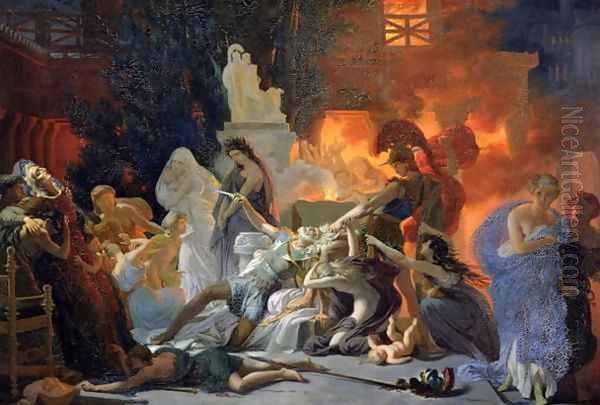
Théodore Géricault (1791-1824): Géricault entered Guérin's studio around 1810, after a period with Carle Vernet. While Géricault's temperament was far more restless and inclined towards the dramatic and the contemporary than Guérin's classical leanings, he undoubtedly benefited from Guérin's rigorous instruction in anatomy and composition. Guérin, despite their stylistic differences, recognized Géricault's immense talent, famously remarking that he had "the stuff of several painters in him." Géricault's masterpiece, The Raft of the Medusa (1819), with its raw depiction of suffering and its dynamic, pyramidal composition, became a seminal work of Romanticism, far removed from Guérin's Neoclassical world, yet built upon a foundation of academic skill that Guérin helped to instill.
Eugène Delacroix (1798-1863): Delacroix joined Guérin's studio in 1815 and remained there for several years. He formed a close friendship with Géricault in the atelier. Delacroix, like Géricault, was drawn to more passionate and exotic subjects than his master. He admired Guérin's ability to convey dramatic emotion, even if he ultimately rejected the constraints of Neoclassicism in favor of a more vibrant use of color, dynamic movement, and emotionally charged narratives, as seen in works like The Death of Sardanapalus (1827) and Liberty Leading the People (1830). Guérin, to his credit, did not try to stifle Delacroix's burgeoning Romanticism, allowing him the space to develop his unique vision. Delacroix himself acknowledged Guérin's kindness and the value of his instruction, even as he forged his own revolutionary path.
Other notable artists who passed through Guérin's studio included Ary Scheffer, a Dutch-French Romantic painter known for his sentimental and literary subjects, and Léon Cogniet, who would also become an influential academic painter and teacher. The atmosphere in Guérin's studio was reportedly one of serious study but also lively discussion, fostering a spirit of inquiry that benefited many young artists.
The Italian Connection: Director of the French Academy in Rome
Guérin's connection with Italy, initiated by his Prix de Rome, was renewed and deepened later in his career. From 1822 to 1828, he served as the Director of the French Academy in Rome, located in the Villa Medici. This prestigious position placed him at the heart of the classical tradition and in charge of mentoring the new generations of Prix de Rome laureates.
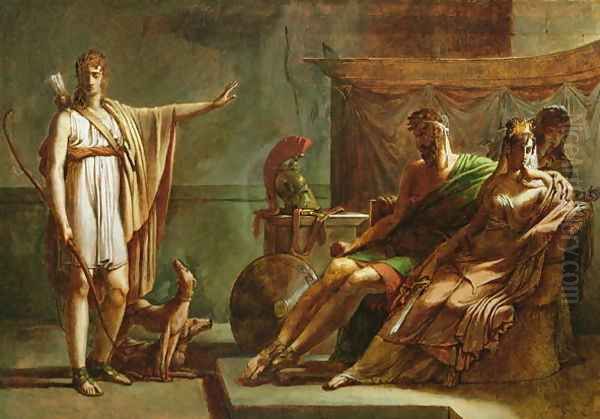
His tenure in Rome was marked by a commitment to upholding the standards of the Academy while also being receptive to the evolving artistic landscape. He encouraged students to study not only classical antiquities but also the works of Renaissance masters like Raphael and Michelangelo. The Italian light, landscapes, and art treasures undoubtedly continued to inform his own artistic sensibilities, even if his personal output began to decline due to failing health. His directorship was generally well-regarded, and he played an important role in maintaining the Academy's prominence during a period of artistic transition. Artists like Jean-Auguste-Dominique Ingres, another towering figure of French Neoclassicism (though more of a contemporary and rival to Guérin's students than a direct pupil of Guérin himself), also spent significant time in Rome, and the city was a crucible for artistic exchange and development.
Style and Technique: Bridging Eras
Guérin's artistic style is best understood as a bridge between the established Neoclassicism of David and the emerging Romanticism of Géricault and Delacroix. While he adhered to many Neoclassical tenets – clarity of form, emphasis on drawing, use of historical and mythological subjects – his work often displayed a heightened emotionalism, a theatricality, and a psychological depth that prefigured Romantic concerns.
His compositions, though balanced, could be dynamic and charged with tension. His figures, while idealized, often conveyed powerful emotions through gesture and facial expression. His use of color, though generally subdued in his earlier works, could be rich and evocative, contributing to the mood of his paintings. He was a master of chiaroscuro, using light and shadow to create dramatic effects and to model his figures with a strong sense of volume.
Compared to David, Guérin's art was often less overtly political and more focused on universal human dramas. He was less concerned with didactic moralizing and more interested in exploring the complexities of human passion and psychology. This focus on individual emotional experience, even within classical narratives, aligned him with the shifting sensibilities of the early 19th century. He was, in essence, a transitional figure, whose work retained the formal elegance of Neoclassicism while embracing a more expressive and dramatic content that appealed to the Romantic imagination.
Interactions with Contemporaries
Beyond his role as a teacher, Guérin was an active participant in the Parisian art world. He exhibited regularly at the Salon, the main public art exhibition, and his works were often subjects of critical discussion. He would have known and interacted with many of the leading artists of his day.
Antoine-Jean Gros, a student of David, was a contemporary known for his dramatic battle scenes and portraits that glorified Napoleon. While Gros also worked within a broadly Neoclassical framework, his use of color and dynamic compositions had a significant impact on the development of Romanticism. François Gérard, another student of David, was a successful portraitist and historical painter. Guérin is known to have frequented Gérard's influential salon, a gathering place for artists, writers, and intellectuals.
The art world of this period was a complex web of influences, rivalries, and friendships. The legacy of David was immense, but artists like Guérin, Gros, and Anne-Louis Girodet (another David pupil known for his more sensual and imaginative interpretations of classical themes) each carved out their own distinct paths, modifying and expanding upon the Neoclassical tradition. Guérin's studio, in particular, became a hub where the classical past met the Romantic future.
Later Years, Health, and Legacy
Guérin's later years were marked by declining health, which limited his artistic production. He continued to paint, but less prolifically. Despite his physical ailments, his reputation remained high. In 1829, he was made a Baron by King Charles X, a testament to his esteemed position in the French art establishment.
He returned to Rome after his directorship of the French Academy, and it was there that he passed away in 1833. He was buried in Rome, the city that had played such a significant role in his artistic development and career.
Baron Pierre-Narcisse Guérin's legacy is multifaceted. As a painter, he created a body of work that exemplified the grace and drama of French Neoclassicism, with masterpieces like The Return of Marcus Sextus and Andromache and Pyrrhus remaining powerful and moving. His ability to infuse classical subjects with genuine emotion and theatrical flair set him apart.
Perhaps even more significantly, his legacy lies in his role as a teacher. By nurturing the talents of Géricault and Delacroix, he inadvertently helped to usher in the Romantic era, even as he himself remained largely committed to Neoclassical principles. His open-mindedness and dedication to his students allowed them to flourish and to challenge the very traditions he represented. He stands as a crucial link in the chain of artistic development, a figure whose influence extended far beyond his own canvases. While sometimes overshadowed by his more revolutionary students or by the towering figure of David, Guérin's contribution to French art, both as a creator and an educator, is undeniable and worthy of continued appreciation. His work reflects the complex artistic and cultural currents of a transformative age, embodying both the enduring power of classicism and the stirring emergence of a new, more passionate artistic vision.